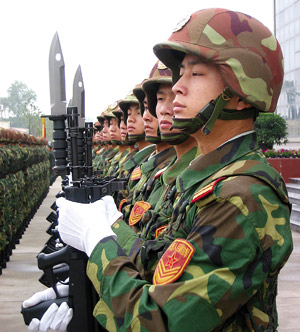INDIAN ARMED FORCES CHIEFS ON OUR RELENTLESS AND FOCUSED PUBLISHING EFFORTS

The insightful articles, inspiring narrations and analytical perspectives presented by the Editorial Team, establish an alluring connect with the reader. My compliments and best wishes to SP Guide Publications.

"Over the past 60 years, the growth of SP Guide Publications has mirrored the rising stature of Indian Navy. Its well-researched and informative magazines on Defence and Aerospace sector have served to shape an educated opinion of our military personnel, policy makers and the public alike. I wish SP's Publication team continued success, fair winds and following seas in all future endeavour!"

Since, its inception in 1964, SP Guide Publications has consistently demonstrated commitment to high-quality journalism in the aerospace and defence sectors, earning a well-deserved reputation as Asia's largest media house in this domain. I wish SP Guide Publications continued success in its pursuit of excellence.
- Appointments Committee of Cabinet approves one-month extension in service of Chief of the Army Staff
- Admiral Dinesh K. Tripathi assumes Command of the Indian Navy as 26th Chief of the Naval Staff
- Prime Minister witnesses 'Bharat Shakti' – a Tri-Services Firing and Manoeuvre Exercise in Pokhran, Rajasthan
- Interim Defence Budget 2024-25 — An Analysis
- Union Defence budget 2024
- Prime Minister Modi Commemorates Indian Navy Day in a Grand Ceremony
Joint commands with Chinese characters

For those who feel that HQ IDS is providing necessary jointness, anyone who has served in HQ IDS will vouch that the organisation is sans powers to enforce jointness in the Services, of which there are numerous examples. Military jointness is an imperative, not luxury. The government needs to take some strong decisions.
China pooh-poohed a report in People’s Daily Online dated January 6, 2014, that People’s Liberation Army (PLA) was going in for structural reforms through pilot establishment of a new joint operational command. The denial was perhaps because China has the history of showcasing a product after it is fully developed/established or is on the verge of it.
Though China’s Ministry of Defence (MoD) termed this report as baseless, People’s Daily Online concluded its finding by saying that the Chinese military has already made “positive explorations” in this regard and that acting on the decision of the Communist Party of China’s (CPC’s) Central Committee will deepen the reform on the basis of thorough research and feasibility study to find a path to establish the joint operational command system with Chinese characters. So, the proposal is apparently on stream. This is more so because: China has been studying and aping US military structures, tactics and technologies for past several years; Chinese Generals as part of Politburo influence and accelerate decision making; China is on the path of active militarism aimed at grabbing more territories on land and sea and; funds are no problem for PLA. On balance, the pilot joint command may well emerge within an year of two of the decision taken.
But while China may soon have the joint operational command, when will the Indian military have its own joint operational command? This vital issue needs urgent focus in view of mounting threats to our national security — the two-and-a-half threat, the proxy wars by China and Pakistan and external forces keen to aiding instability in India in their own perceived national interests as we see happening in many countries including the Middle East.
There are multiple reasons for such decision not being taken. There always is resistance to change. There also is the bureaucratic fear that establishment of Theatre Commands would eventually lead to the establishment of a Chief of Defence Staff (CDS), which in turn is apparently perceived encroachment on bureaucratic turf. It is for similar reason that HQ IDS has not been permitted to merge into MoD, as was envisaged. Prime Minister Manmohan Singh addressing the Combined Commanders Conference in 2004 had stated, “Reforms within the armed forces also involve recognition of the fact that our navy, air force and army can no longer function in compartments with exclusive chains of command and single service operational plans.” Yet going by media reports, the political authority is averse to even a permanent chairman of the Chiefs of Staff Committee (COSC), as recommended by the Naresh Chandra Committee, and operational responsibility of HQ IDS continues to be restricted only to Out of Area Contingencies (OOAC); a sliver of overall operational responsibility.
The permanent chairman of COSC can at best be a stopgap arrangement is no substitute for the CDS. By showcasing permanent chairman of COSC as prelude to eventually establishing a CDS (slow change), the bureaucracy has effectively rolled the dice to delay the CDS for perhaps another few decades.
Since the political authority is dependent on bureaucratic advice, all the aces are held by the latter. Then is the perceived fear of loss of turf by the service chiefs themselves, despite HQ IDS having analysed five studies on Theatre Commands and examined the same at DGMO and equivalent level of the three services (or their representatives) and found such re-organization to the benefit of all.
General S. Padmanabhan, former Chief of the Army Staff, had said, “There is no escaping the military logic of creating suitably constituted Integrated Theatre Commands and Functional Commands for the armed forces as a whole.” Yet, the service chiefs continue to resist Theatre Commands. This has been the case in most countries. In Britain, after 18 years of squabbling, the political authority thrust jointness on the military by appointing CDS. For those who feel that HQ IDs is providing necessary jointness, anyone who has served in HQ IDS will vouch that the organisation is sans powers to enforce jointness in the Services, of which there are numerous examples. Military jointness is an imperative, not luxury. The government needs to take some strong decisions.
The views expressed herein are the personal views of the author.





